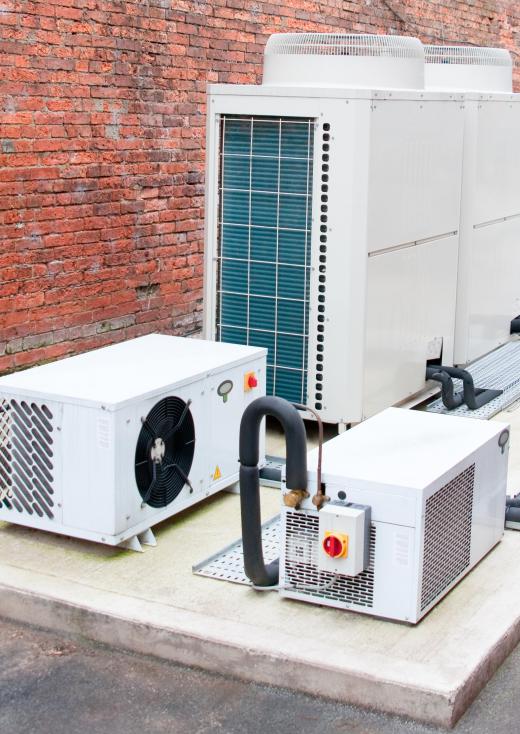A condensing unit is a device that is used to condense a gaseous substance back into its liquid form through cooling. A condenser unit technically is a type of heat exchanger, and its size varies from an extremely small device all the way to large, industrial-size units. Condensing units also are incredibly varied in application, with uses such as cooling in refrigerators, air conditioners, chemical reactions and especially steam turbine power plants. Water typically is used as a coolant in the condensing process, but other forms of coolants also have been employed successfully.
A surface condenser is a type of condensing unit often found in steam power plants. A typical steam cycle consists of water being preheated and brought to its boiling point, at which time it is vaporized, or superheated, into high-pressure steam. This steam is delivered to a series of turbines, where after going through multiple cycles, is condensed back into water. The condensing process is an extremely important part of the steam cycle, because it allows for a steam plant to recycle steam that otherwise would have been wasted. For this reason, condensers help increase efficiency in steam power plants by reducing water demands.

Typically, surface condensers consist of a shell and tube construction. This is where cold water runs through a series of tubes within a metal shell filled with exhausted steam. The cool water brings the pipes to a relatively low temperature, which then cools the steam within the shell. After the steam is condensed, water is collected below the unit in a hot well. On smaller steam applications, the condensing unit can take a form similar to a car radiator.
Another common type of condensing unit is an air conditioner condensing unit. This is only one part of three essential components in an air conditioning unit. First, a condensing unit condenses refrigerant vapor into a liquid form. Second, much like a pump, a compressor creates a steady flow of refrigerant liquid, where it moves along to the the third stage. This third stage consists of a fan or blower, which blasts cold air created from the cooling effect of the flowing refrigerant liquid.
Condensing units also are commonly used in chemical applications. A laboratory condensing unit, however, is far different from what one would see in a steam power plant or an air conditioner. Unlike common heat exchangers, laboratory and chemical condensers consist of a large glass tube through which water flows. In the middle of this larger tube is another smaller tube, into which a hot vapor enters. Upon entry, the cooling effect of the water surrounding it brings the vapor to a temperature at which it can condense.
A common use for laboratory condensers is the distillation of water. Water contains many impurities that are unwanted in heating and chemical processes. When heated to the point at which water is evaporated, small, impure deposits can be left behind. In steam power plants, this is very undesirable, because these deposits can result in corrosion. In chemical applications, the presence of impurities also can result in an unwanted chemical reaction.
Another type of condensing unit is known as a direct contact condenser. In this type, the gas and cooling liquid come in direct contact. When used, the liquid and gas being combined are identical substances in different forms, such as the combination of water and steam.
